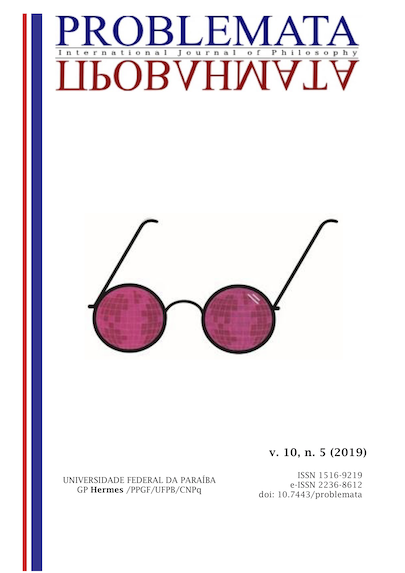COOPERATION AND EMPATHY:
AN ARTICULATION IN FAVOR OF THE NATURAL FOUNDATIONS FOR MORALITY
DOI:
https://doi.org/10.7443/problemata.v10i5.45375Keywords:
Empathy, Cooperation, Ethology, Hume, EvolutionAbstract
The objective of this paper is to bring theoretical and empirical subsidies that can base a naturalistic approach to the moral phenomenon. Morality, in this article, will be understood as a necessary phenomenon for the maintenance of group life of social mammals of complex life. This hypothesis will be defended throughout this work, from the defense of a relationship between empathy and cooperation within the group of great primates, more specifically in the communities of Chimpanzés (Pan troglotydes versus). This research is anchored by the discoveries made by Hume, mainly in the discussions around his proposal to deal with the questions pertaining to the field of moral philosophy from the use of experimental methods, as well as by new advances in the biological and cognitive sciences that allow to search new resolutions to the questions that have been present for centuries in the speculative field of moral philosophy. The ethnological researches with primates provide indispensable subsidies for the support of the hypothesis that some emotions appear in response to certain socially considered facts of great value. In this way, I try to demonstrate that the indispensable elements for the emergence of a certain moral phenomenon are contained in the biological structure of social mammals of complex life. Certainly, the empirical and theoretical data brought by this research contribute significantly to support the argument for a theory that seeks to understand morality through evolutionary foundations.
Downloads
References
ALEXANDER, R. The Biology of Moral system. De Gruyter, New York, 1987.
AVELAR, T. MATOS,M. Seleção de Parentesco e altruísmo. Análise Psicológica, 1-2-3 (VII),p.57-62, 1989.
AXELROD, R. The evolution of Cooperation. Basic Books, New York, 1984.
BARD, K. (2007). Neonatal imitation in chimpanzees (Pan Troglodytes) tested with two paradigms. Animal Cognition, 10, 233–242.
BRITO, A. N. de. 2001. Hume e o empirismo na moral. Philósophos, Goiânia, v.6, n. 1 e 2, p.11-25.
CASANOVA, C., R. CEBALLOS, P.C. LEE. Innovate Social Behavior in Chimpanzees,2008.
______. Introdução à Antropologia Biológica: Princípios Evolutivos, Genética e Primatologia.Lisboa: ISCSP,2006.
(Pan troglodytes). American Journal of Primatology, 70: 54-61.
CARVALHO, J. Comportamento Social em Chimpanzés ( Pan troglodytes): Manutenção de Estatuto Social e Hierarquia Social de Dominância, Lisboa. 2008.68f. Dissertação (Mestrado em Biologia Humana e Ambiente)- Faculdade de ciências da Universidade de Lisboa- Centro de Biologia Ambiental.
COLLINGE, N. Introduction to Primate Behavior. Kendall/Hunt Publishing Company. Iowa,1993.
CRAILSHEIM. et al. Social competence of adult chimpanzees (Pan troglodytes) with severe deprivation history: I. An individual approach.Developmental Psychology, [s.l.], v. 47, n. 1, p.77-90, 2011. American Psychological Association (APA).
DARWIN, C. The Origin of Species by Means Of Natural Selection, or the Preservation of Favored Races in the Struggle for Life. 6 ed.London: John Murray, 1872a.
________. The expression of the emotion in Man and Animals. New York. D Appleton Company, 1872b.
_______. The Descent of man, and selection in relation to sex. New Jersey. Princeton University. 1981.961p.
DARWALL,S.(1998).Empathy,sympathy, care.Philosophical Studies, 89,261-282.7
DE WAAL, F. Good natured: The origins of right and wrong in humans and other animals. Cambridge, MA: Harvard University Press,1996.
_______. 1989. Food sharing and reciprocal obligations among chimpanzees. Journal of Human Evolution, 18: 433–459.
DUNBAR, R. I. M. The social brain hypothesis. Evolutionary Anthropology, 6, 178-190, 1998.
ESTRADA, A. Comportamiento animal: el caso de los primates. México: Fondo de Cultura Económica, 1991. 172 p.
FISHER,RA. The genetical Theory of Natural Selection. Clarendon Press, Oxford, 1930.
GOODALL, J. The Chimpanzees of Gombe. Patterns of Behavior. The Belknap Press of Havard University Press. Cambridge , Massachusets, and London, England,1986.
HAMILTON, W.D. The genetical evolution of social behaviour. I,II. J. Theor Biol.7,1-52,1964.
HEPPER,P,G. Kin recognition: functions and mechanisms. A review. Biol.Rev,1986.
HUME, D. Investigações sobre o entendimento humano e sobre os princípios da moral. Traduzido por José Oscar de Almeida Marques. São Paulo, Unesp, 2004.
_________. Tratado da natureza humana: uma tentativa de introduzir o método experimental de raciocínio nos assuntos morais. Traduzido por Débora Danowski. São Paulo, Unesp, 2009.
_________. Do contrato original. In: Ensaios Morais, Políticos e Literários. Lisboa: Imprensa Nacional-Casa da moeda, 2002
HU, H.Y, et al.Evolutionofthehuman-specificmicroRnAmiR-941.NatureCommunications|3:1145|DoI:10.1038/ncomms2146, 2012.
LIEBERMAN, C.et al. Nature 433, 312, 2005.
MESQUITA, M. O papel dos mecanismos psicobiológicos de sociabilidade no comportamento moral, 2015,143f. Tese. (Tese em filosofia)- Escola de Humanidades, Universidade do Vale do Rio dos Sinos, São Leopoldo.
NOWAK,M. Five Rules for the Evolution of Cooperation. Science, vol 314, 2019.
KREBS,J.R. DAVIES,N.B. An introduction to behavioural ecology.2nd. Oxford: Ed. Blackwell Scientific Publication,1987.
REALE, G. História da Filosofia: do Humanismo a Kant. São Paulo, Paulus,
PLUTCHIK, R. (1987). Evolutionary bases of empathy. In: N. Eisenberg, & J. Strayer (Eds.), Empathy and its development (pp. 38-46). New York: Cambridge University Press.
TUGENDHAT, E. Lições sobre ética. 1. ed. Petrópolis: Vozes, 1997
PRESTON, S. D. DE WALL, F. B. M. (2002). The communication of emotions and the possibility of empathy in animals. In: Altruistic love: Science, philosophy, and religion in dialogue, ed. S. Post, L. G. Underwood, J. P. Schloss & W. B. Hurlburt. Oxford University Press.
Downloads
Published
Issue
Section
License
Authors who publish with this journal agree to the following terms:
- Authors retain copyright and grant the journal right of first publication with the work simultaneously licensed under a Creative Commons Attribution License that allows others to share the work with an acknowledgement of the work's authorship and initial publication in this journal.
- Authors are able to enter into separate, additional contractual arrangements for the non-exclusive distribution of the journal's published version of the work (e.g., post it to an institutional repository or publish it in a book), with an acknowledgement of its initial publication in this journal.
-
- Authors are permitted and encouraged to post their work online (e.g., in institutional repositories or on their website) prior to and during the submission process, as it can lead to productive exchanges, as well as earlier and greater citation of published work (See The Effect of Open Access).





